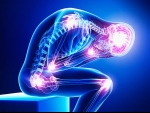Home »
Blog » Back Pain
| Stem Cell, PRP, Acupuncture in Queens & Long Island, New York
Back Pain | Stem Cell, PRP, Acupuncture in Queens & Long Island, New York
Tags: Back Pain | Posted on: 05-Nov-2021 | No of views: 5336 When you have back pain, your doctor may recommend muscle relaxants—a group of drugs that are typically obtained with a doctor’s prescription. These drugs have the potential to decrease tension and spasm within a sore muscle, which may reduce pain. Here are 6 important facts that you must know if you plan to take muscle relaxants for back pain: 1. Muscle Relaxants Are Typically a Second-Line Treatment for Back Pain
Read more
Tags: Back Pain | Posted on: 01-Nov-2021 | No of views: 6141 If you’re dealing with persistent pain, or work with pain patients, central sensitization is a big deal. PainScience.com publisher, Paul Ingram writes: "There is great variety in acute pain, but chronic pain is often defined by pain sensitization, regardless of how it all started. And world-leading pain scientist, Professor Lorimer Moseley adds: "...fear of movement, pain catastrophizing, anxiety, and nervous system sensitization appear to be the main contributors to pain and disability."
Read more
Tags: Back Pain | Posted on: 29-Oct-2021 | No of views: 5267 The term sciatica refers to a set of symptoms, such as pain, tingling, numbness, or weakness that radiates along your sciatic nerve which typically courses from your lower back down to your feet. The medical term for sciatica is lumbar radiculopathy—a condition where spinal nerve roots in the lower back get irritated or compressed, sending pain and/or neurological symptoms into your lower extremities.
Read more
Tags: Back Pain | Posted on: 22-Oct-2021 | No of views: 5265 Though degenerative disc disease can cause debilitating neck or back pain which may also radiate into the arm or leg, there are many treatment options. Some treatments may be more beneficial and effective than others based on the individual, so here are several options to consider trying in order to reduce pain.
Read more
Tags: Back Pain | Posted on: 20-Oct-2021 | No of views: 5261 Plantar Fasciitis - It’s the most common cause of pain on the bottom of your heel. The ligament that connects the front and back of your foot and supports your arch gets swollen and irritated. Though it’s hard to know exactly what causes it, you’re more likely to get it if you repeat the same impact on your feet (when you run, for example). It’s more common when you start out.
Read more
Tags: Back Pain | Posted on: 18-Oct-2021 | No of views: 4763 When our back hurts, we instinctively believe it’s because we’ve injured the area. After all, most pain works this way. When we cut our fingers, we see blood and feel pain. When we get the flu, our body hurts as it battles the virus. But persistent back pain is different. Decades of research prove that there simply isn’t a close connection between the condition of the spine and the likelihood of experiencing pain.
Read more
Tags: Back Pain | Posted on: 15-Oct-2021 | No of views: 7392 A herniated disc in the upper back, also called a thoracic herniated disc, can cause a variety of symptoms including pain, numbness, and weakness. While sharp, axial back pain that worsens with activity is most common, other signs and symptoms can include:
1-Burning and/or electric-like pain that localizes to the back or radiates circumferentially around the chest or abdomen. 2-Similar shock-like pain can radiate into the legs. 3-Sensory disturbances, including tingling and numbness, may be experienced at or below the level of the herniated disc.
Read more
Tags: Back Pain | Posted on: 11-Oct-2021 | No of views: 4906 Find your sweet spot by learning how to push yourself, but not too far. Acute pain is pain that indicates something is wrong. It has a specific precipitant (injury, infection, or illness) and subsides within a few days to about a month. In contrast, chronic pain is pain that is ongoing; with pain signals that serve no useful physiological purpose yet remain active in the nervous system for months and often years, with no end-point. It’s not unlike a smoke detector that becomes stuck in the “on” mode, continuously sounding a harrowing alarm at high volume. Chronic pain is a disorder unto itself.
Read more
Tags: Back Pain | Posted on: 08-Oct-2021 | No of views: 5180 Your every day habits can play a role in developing chronic back pain. Here are a few simple things to keep in mind each day to reduce back pain. 1. Support Your Spine at Your Desk - Compared to standing, sitting places increased stress on your spine and spinal discs. So prolonged sitting with poor postures, such as slouching forward, may contribute to back pain.1 Here are a few tips to better support your lower back while you sit: Keep knees bent at about a 90-degree angle with feet flat on the ground. If needed, adjust your seat height so that your hips are about the same height as or slightly higher than your knees, which reduces stress on your lumbar spine.
Read more
Tags: Back Pain | Posted on: 01-Oct-2021 | No of views: 5423 If you have lower back pain or sciatica, you probably want to know how to relieve your pain and prevent flareups or recurrences. Avoiding bed rest and staying active can help you do both. Staying active can include a combination of strategies, such as continuing your daily activities, adding a simple exercise, such as short walks, and/or following a structured and guided exercise program. This blog explains the potential side effects of continued bed rest and the unique benefits of engaging in low-impact physical activities with back pain.
Read more
Love this Post? Spread the World
























